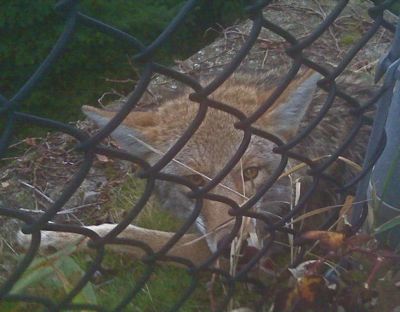
After the Seattle Animal Shelter confirmed on Tuesday that one of its officers rescued that coyote from the precarious Jack Block Park (map) perch where Chris Weinmann photographed it on Saturday, we had the same question you did … how did the officer pull that off? So we asked SAS boss Don Jordan if he could put us in touch with the officer, and today he did. Quite the story – read on:

First of all, Jordan stressed in our followup conversation today, this was an anomaly – SAS has never done anything like this before, but “it was a smart move on our part” – not only was the coyote in danger, Jordan explained, but there was concern that if it was just left there, some would-be Good Samaritan might have attempted an amateur rescue, and hurt him/herself as well as the animal. (Chris’s wider shot above shows just how precarious the situation was.)
So that’s where Officer Neil Deruyter came in.
The rescue wasn’t a first for him – he spent several years working with PAWS: “I knew what he would do, what his actions would be. I know coyotes and their demeanor, and they’re very skittish. When I worked with them, they would literally stay put … you could walk on top of them and they wouldn’t scatter necessarily. Most people don’t realize, they’re very shy creatures.”
Deruyter has no idea how the coyote got to that perch on a ledge near the main Jack Block lookout. “I don’t know how he got there, maybe chasing prey, or followed a trail and got stuck … I couldn’t see how he would have climbed up there; maybe he got through the railing, got on the other side of the railing, and couldn’t find his way back.”

To rescue the coyote — which Deruyter estimates was about a year old (“nice-looking teeth”), 25 to 30 pounds, though he’s not sure if it was male or female — he and the observer with him had to work through that railing. “I reached over and put the catch pole around him, and lifted him over the railing … My observer had the net behind him. His options were, be lifted over, or else he was going down 50 feet. He stayed right there, extremely terrified, frozen with fear, even once I got him off the ledge.”
Deruyter had to figure out what to do with the rescued coyote: “So we loaded him up on the vehicle and took him to Schmitz (Park), which I knew was still quiet, so he’d be able to hide in some vegetation.”
We asked if what a WSB’er had e-mailed us was true, that he’d asked dog walkers to leave the park before the release. Deruyter acknowledged encountering some people in the park with dogs, and says he told one he’d be releasing an animal and it would be nice “for the animal’s sake” if they could leave the area so as not to frighten the coyote further. “She exited the park and was very appreciative, but I didn’t demand that anybody leave. I’ve released a lot of wildlife in my years, wildlife rehab work too, and the less people around (the better).”
One more thing he wanted to say about the coyote he rescued: It almost looked like a three-legged coyote when he got a good look at it — “he or she did have a front right leg that was deformed, might have been a birth defect, maybe caught in a trap, but it was perfectly fine, and moved very quickly (after being released). … He looked great as he was running away.”
So will SAS personnel routinely intervene if a wild animal’s in trouble? According to director Jordan, “Our general rule is that unless a wild animal is injured or deceased, it’s not something that we intervene or deal with … but in this business it’s never cut and dried, yes or no, it’s always on a case-by-case basis. We don’t want to discourage anyone from calling. We still want people to call, so at least we can answer their questions.”

| 9 COMMENTS